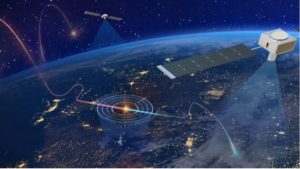The Missile Defense Agency (MDA) plans to narrow down its competitors for hypersonic missile defense later this year, the agency’s director said Wednesday.
“We have a Other Transaction Authority agreement in place with three separate companies that are competing now. We are evaluating those concepts for down-select later this year. So we will go from the current three down to the two, perhaps the one depending on the maturity of those different proposals,” MDA Director Vice Adm. Jon Hill told the House Armed Services’ strategic forces subcommittee during a hearing on May 11.
Last November, MDA selected
Raytheon Technologies [RTX], Lockheed Martin [LMT] and Northrop Grumman [NOC] to work on accelerated concept designs for a hypersonic missile defense interceptor, with each winning $19 to $21 million for the refocused Glide Phase Interceptor (GPI) program. The work is expected to be finished by September 2022 (Defense Daily, Nov. 22, 2021).
MDA hopes to use the GPI to intercept hypersonic weapons while they are in the glide phase of flight, after they re-enter the Earth’s atmosphere.

In early 2021, MDA changed its plans for a counter-hypersonic defense system by reforming the Regional Glide Phase Weapon System (RGPWS) into the nearer-term GPI and a longer term continuing science and technology effort (Defense Daily, Feb. 4, 2021).
MDA previously said the GPI is expected to be integrated with a modified Baseline 9 Aegis Ballistic Weapon System and the interceptors specifically fired from Navy Arleigh Burke-class Aegis missile defense destroyers using standard Vertical Launch System cells.
Hill admitted the agency does not yet have a good sense of how much de-risking needs to be done on GPI yet, as they go through evaluations.
“But if we see areas where there are major risk areas that we want to help industry overcome, that’s what those investments will be tied to,” Hill added.
Hill also noted MDA is on track to bring two interoperable prototype Hypersonic Ballistic Tracking Space Sensor (HBTSS) satellites to orbit in March 2023, as better tracking is key to intercepting hypersonic missile targets.
HBTSS “has two major roles. The first is to pick up the dim targets that cannot be seen by the current architecture today. So from a ballistic perspective, we’re seeing changes there that make that fight much more challenging. But when you get to the advanced hypersonic threat, which has a global maneuver capability, we need the ability to see it from space. So global coverage, and that very close proximity from space to track those sensors,” Hill said.
He said MDA will put the HBTSS prototype satellites in an inclination where they can monitor a test in the Indo-Pacific Command region.
“We will collect that data as a way to prove out the concept. Did a lot of work on the ground to show that we can extract those hot targets over warm earth. Now it’s about getting it into space and pulling that data down,” Hill continued.
The MDA director said the agency is staying closely aligned with U.S. Space Force as they make decisions on the overall hypersonic tracking architecture.
“Our vision is that the HBTSS will be a part of the overall constellation for dealing with that global maneuvering threat.”
Lt. Gen John Shaw, deputy commander of U.S. Space Command, also told the subcommittee his force is “interested in any capabilities that are going to help us with any of these threats. And as MDA has pursued this particular program, HBTSS, the advantage of this is that we have a perspective from space that is invaluable, and will allow us to go after a lot of these threats.”